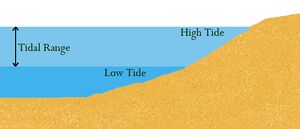Earth:Tidal range
Tidal range is the difference in height between high tide and low tide. Tides are the rise and fall of sea levels caused by gravitational forces exerted by the Moon and Sun, by Earth's rotation and by centrifugal force caused by Earth's progression around the Earth-Moon barycenter. Tidal range depends on time and location.
Larger tidal range occur during spring tides (spring range), when the gravitational forces of both the Moon and Sun are aligned (at syzygy), reinforcing each other in the same direction (new moon) or in opposite directions (full moon). The largest annual tidal range can be expected around the time of the equinox if it coincides with a spring tide. Spring tides occur at the second and fourth (last) quarters of the lunar phases.
By contrast, during neap tides, when the Moon and Sun's gravitational force vectors act in quadrature (making a right angle to the Earth's orbit), the difference between high and low tides (neap range) is smallest. Neap tides occur at the first and third quarters of the lunar phases.
Tidal data for coastal areas is published by national hydrographic offices.[1] The data is based on astronomical phenomena and is predictable. Sustained storm-force winds blowing from one direction combined with low barometric pressure can increase the tidal range, particularly in narrow bays. Such weather-related effects on the tide can cause ranges in excess of predicted values and can cause localized flooding. These weather-related effects are not calculable in advance.
Mean tidal range is calculated as the difference between mean high water (i.e., the average high tide level) and mean low water (the average low tide level).[2]
Geography
The typical tidal range in the open ocean is about 1 metre (3 feet) (blue and green on the map on the right). Closer to the coast, this range is much greater. [citation needed] Coastal tidal ranges vary globally and can differ anywhere from near zero to over 11 m (36 ft).[3] [failed verification] The exact range depends on the volume of water adjacent to the coast, and the geography of the basin the water sits in. Larger bodies of water have higher ranges, and the geography can act as a funnel amplifying or dispersing the tide.[4] The world's largest tidal range of 11.7 metres (38.4 feet) occurs in Bay of Fundy, Canada ,[3][5] [failed verification] a similar range is experienced at Ungava Bay also in Canada[6] and the United Kingdom regularly experiences tidal ranges up to 15 metres (49 feet) between England and Wales in the Bristol Channel.[7]
The fifty coastal locations with the largest tidal ranges worldwide are listed by the National Oceanic and Atmospheric Administration of the United States .[3]
Some of the smallest tidal ranges occur in the Mediterranean, Baltic, and Caribbean Seas. A point within a tidal system where the tidal range is almost zero is called an amphidromic point.

Classification
The tidal range has been classified[9] as:
- Micro-tidal – when the tidal range is lower than 2 metres (6'6¾").
- Meso-tidal – when the tidal range is between 2 metres and 4 metres (6'6¾" and 13'1½").
- Macro-tidal – when the tidal range is higher than 4 metres (13'1½").
See also
- King tide, an informal term for an especially high spring tide
References
- ↑ "Hydrographic and Oceanographic Agencies". http://co-ops.nos.noaa.gov/faq3.html.
- ↑ NOAA. "Tidal Datums". https://tidesandcurrents.noaa.gov/datum_options.html.
- ↑ 3.0 3.1 3.2 NOAA. "FAQ Where are the highest tides?". https://tidesandcurrents.noaa.gov/faq.html#08.
- ↑ NOAA. "It appears that the range of the tides gets larger the further the location from the equator. What causes this??". https://tidesandcurrents.noaa.gov/faq2.html#27.
- ↑ NOAA. "The highest tide in the world is in Canada.". http://oceanservice.noaa.gov/facts/highesttide.html#26.
- ↑ Charles T. O'Reilly, Ron Solvason, and Christian Solomon. "Resolving the World's largest tides", in J.A Percy, A.J. Evans, P.G. Wells, and S.J. Rolston (Editors) 2005: The Changing Bay of Fundy-Beyond 400 years, Proceedings of the 6th Bay of Fundy Workshop, Cornwallis, Nova ScotiSackville, NB.
- ↑ "Tidal range". https://www.surgewatch.org/definition/tidal-range/.
- ↑ Picture credit: R. Ray, TOPEX/Poseidon: Revealing Hidden Tidal Energy GSFC, NASA. Redistribute with credit to R. Ray, as well as NASA-GSFC, NASA-JPL, Scientific Visualization Studio, and Television Production NASA-TV/GSFC
- ↑ "The effect of tidal range on beach morphodynamics and morphology: a conceptual beach model". Journal of Coastal Research 9 (3): 785–800. 1993. ISSN 0749-0208.
 |




